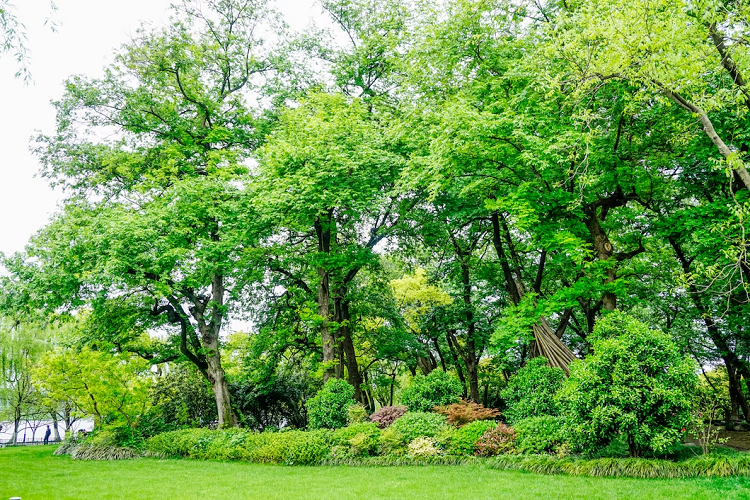Creating a wildlife-filled garden is a rewarding and enriching experience. Embracing nature not only beautifies your surroundings but also attracts a diverse range of wildlife, from birds and butterflies to beneficial insects. One of the key elements to achieving a thriving wildlife habitat is the selection of trees and foliage that provide food, shelter, and nesting opportunities for various species. In this guide, we’ll explore some of the best trees and foliage that can transform your garden into a haven for wildlife.
Native Trees: The Backbone of Biodiversity
When it comes to attracting wildlife, native trees play a pivotal role. These trees have evolved alongside local fauna, offering a host of resources essential for their survival. Native trees provide familiar food sources, nesting sites, and safe havens for various wildlife species. Additionally, their growth patterns are well-adapted to the local climate, making them hardy and resilient.
-
Oak Trees
Oak trees (Quercus spp.) are ecological powerhouses and attract an astonishing array of wildlife. Their acorns provide a vital food source for squirrels, deer, and various birds like woodpeckers and jays. Moreover, oak trees support hundreds of caterpillar species, which are essential for feeding young birds during the breeding season. These majestic trees also create nesting sites for birds and shelter for numerous insects.
-
Birch Trees
Birch trees (Betula spp.) are not only known for their striking beauty but also for their significance in attracting wildlife. The seeds from birch catkins are an excellent food source for finches and other small seed-eating birds. Additionally, the insect life that birch trees support makes them an attractive foraging site for birds like chickadees and warblers. Birch trees also offer nesting opportunities for cavity-nesting birds like nuthatches and woodpeckers.
Fruit-Bearing Trees: A Feast for Feathered Friends
Fruit-bearing trees are a magnet for many bird species, which rely on the abundant food supply these trees offer. The presence of fruit trees ensures that your garden remains a vibrant hub of avian activity throughout the year.
-
Apple Trees
Apple trees (Malus domestica) are a popular choice for wildlife gardens due to their delicious fruits. Not only do they provide sustenance for humans, but the apples also attract a variety of birds, including robins, thrushes, and waxwings. Fallen apples on the ground can be a valuable food source for small mammals as well. Additionally, the dense foliage of apple trees offers excellent shelter for birds and insects.
-
Cherry Trees
Cherry trees (Prunus spp.) are another fantastic option for attracting wildlife. The sweet cherries are a hit with birds such as blackbirds, song thrushes, and starlings. Furthermore, the cherry blossoms in spring attract bees and other pollinators, contributing to a healthy ecosystem. The dense canopy of cherry trees offers excellent nesting sites for birds, making them a welcoming habitat for a wide range of avian species.
-
Fig Trees
Fig trees (Ficus carica) are not only delicious but also support various wildlife. The sweet fruits are a favorite among birds such as blackbirds and thrushes. Figs are also host plants for several butterfly species, providing a food source for caterpillars. The thick foliage of fig trees offers protection and shade for many small critters, making them a valuable addition to any wildlife garden.
Flowering Shrubs: A Haven for Pollinators
Incorporating flowering shrubs into your garden not only adds a splash of color but also attracts vital pollinators such as bees and butterflies. These shrubs provide nectar and pollen for pollinators, playing a crucial role in supporting their populations.
-
Butterfly Bush
The butterfly bush (Buddleja spp.) is aptly named for its ability to attract a myriad of butterflies. With its abundant nectar-rich flowers, it entices not only butterflies but also bees and hummingbirds. This shrub is a must-have for any wildlife garden, as it creates a vibrant and dynamic atmosphere filled with fluttering wings.
-
Lilac
Lilacs (Syringa spp.) are not only cherished for their enchanting fragrance but also their appeal to pollinators. Bees are particularly drawn to the lilac’s nectar, making it an essential pit-stop for these busy insects. Lilacs also attract butterflies and other beneficial insects, making them an excellent addition to your wildlife garden.
Evergreen Trees: Year-Round Shelter
While deciduous trees offer a bounty of resources during the growing season, evergreen trees provide year-round shelter and protection for wildlife. Their dense foliage serves as a haven during harsh weather and provides safe nesting sites for various species.
-
Pine Trees
Pine trees (Pinus spp.) are a staple in many wildlife gardens due to their evergreen nature and numerous benefits. Their seeds, known as pine nuts, are a vital food source for birds and small mammals. Additionally, the dense branches of pine trees offer excellent shelter for birds and other creatures, protecting them from cold temperatures and predators. The rough bark provides nesting opportunities for cavity-nesting birds like owls and chickadees.
-
Juniper Trees
Juniper trees (Juniperus spp.) are known for their hardiness and adaptability to various environments. Their blueish berries are rich in nutrients and attract birds like thrushes and cedar waxwings. The dense foliage of juniper trees provides protection for birds, small mammals, and insects throughout the year. Moreover, some bird species, such as the cedar waxwing, use juniper trees for nesting, making them an important habitat element in a wildlife garden.
Conifers: Shelter and Nourishment in Winter
Conifers are another excellent addition to a wildlife garden, especially during the winter months when food and shelter are scarce. These trees provide a reliable source of food and refuge for various animals.
-
Spruce Trees
Spruce trees (Picea spp.) are coniferous giants that have a significant impact on wildlife. Their seeds, called spruce cones, are an important food source for birds, including pine grosbeaks and red crossbills. The thick branches of spruce trees offer excellent shelter for birds, while their dense foliage protects smaller critters from cold and harsh winds. Owls and other raptors often use spruce trees as roosting sites, adding another layer of biodiversity to your garden.
-
Fir Trees
Fir trees (Abies spp.) are renowned for their distinctive fragrance and appeal to wildlife. The seeds found in fir cones are favored by various bird species like crossbills and siskins. These evergreen trees offer essential shelter for birds and mammals, creating a safe haven during winter storms and harsh conditions. Adding fir trees to your wildlife garden ensures a year-round spectacle of feathered visitors and furry inhabitants.
Berry-Producing Shrubs: A Feast for Birds
Berry-producing shrubs are not only a visual delight but also a fantastic food source for birds. These shrubs provide nutrient-rich berries, attracting a wide range of bird species throughout the year.
-
Elderberry
Elderberry (Sambucus spp.) is a remarkable shrub that offers numerous benefits to wildlife. Its clusters of small, dark berries are highly sought after by birds like thrushes, finches, and grosbeaks. Moreover, elderberry flowers attract bees and butterflies, supporting pollinators in your garden. The dense growth of elderberry shrubs provides excellent nesting sites and shelter for small birds, making it a valuable addition to any wildlife-friendly landscape.
-
Serviceberry
Serviceberry (Amelanchier spp.), also known as Juneberry or Saskatoon, is a versatile shrub that caters to wildlife needs. The sweet berries attract a variety of birds, such as robins, bluebirds, and waxwings. Serviceberry blooms in early spring, providing an early source of nectar for bees and butterflies. Additionally, the dense foliage and branching structure of serviceberry shrubs create suitable habitats and cover for nesting birds and other small animals.
Deciduous Trees with Nesting Cavities
Trees with nesting cavities play a crucial role in providing safe and secure nesting sites for various bird species. These trees are especially important for cavity-nesting birds, which rely on existing holes or crevices for their nesting needs.
-
Willow Trees
Willow trees (Salix spp.) are renowned for their flexibility and rapid growth. These trees provide an array of nesting opportunities for birds that prefer to build nests close to water sources. Warblers, finches, and woodpeckers are among the many bird species that rely on willow trees for nesting. The long, drooping branches offer shelter and protection, making willows a favoured location for birds to raise their young.
-
Hollow Oak Trees
Old, hollowed-out oak trees offer an extraordinary habitat for wildlife. These ancient trees often have cavities that provide shelter for numerous species, including owls, bats, raccoons, and squirrels. These hollowed-out oaks also serve as important foraging sites for insects, which in turn attract insect-eating birds and other creatures. Preserving old oak trees and encouraging their natural decay is a sustainable way to provide nesting cavities and support biodiversity in your garden.
Host Plants for Butterflies
Attracting butterflies to your garden is not only visually stunning but also contributes to the pollination of plants and supports their life cycle. By incorporating specific host plants, you can encourage butterflies to lay their eggs and witness the transformation from caterpillars to beautiful winged adults.
-
Milkweed
Milkweed (Asclepias spp.) is a critical host plant for monarch butterflies. Monarch caterpillars exclusively feed on milkweed leaves, making it essential for their survival. By planting milkweed in your garden, you provide a lifeline for these iconic butterflies during their annual migration. Moreover, milkweed flowers offer nectar for various pollinators, enhancing the ecological value of your garden.
Fruit-Producing Vines: Attractive Shelter and Food Source
Vines are an excellent addition to a wildlife garden, as they provide vertical structure, shelter, and fruit that attracts a wide range of wildlife.
-
Grape Vines
Grape vines (Vitis spp.) are not only valued for their fruit but also for the shelter they provide for birds. The foliage of grapevines offers nesting opportunities for birds, and the sweet grapes attract various bird species, including robins and cedar waxwings. Additionally, grapes can be a valuable food source for small mammals during the autumn months.
Conserve Water Sources
Water is a vital element for wildlife, and by providing a water source, you can attract even more species to your garden. Adding a birdbath, pond, or small water feature creates a watering hole for birds, butterflies, and other critters, especially during hot and dry periods.
-
Birdbaths
Birdbaths are simple yet effective ways to attract birds to your garden. Place a birdbath at ground level for small birds or elevate it on a pedestal to accommodate larger bird species. Keep the birdbath clean and filled with fresh water regularly to ensure it remains an appealing water source for wildlife.
Welcoming Wildlife All Year Round
Incorporating the right trees and foliage into your garden is the key to creating a thriving wildlife habitat. Native trees like oaks and birches provide a solid foundation for biodiversity, while fruit-bearing trees like apples and cherries attract a diverse array of birds and insects. Flowering shrubs such as butterfly bushes and lilacs entice vital pollinators like bees and butterflies, contributing to the health of your garden ecosystem. Evergreen trees like pines and junipers offer year-round shelter and sustenance, while conifers like spruces and firs provide crucial resources during the winter months.
By carefully selecting and planting these trees and foliage in your garden, you’ll transform it into a haven for wildlife, witnessing a symphony of nature unfold before your eyes. Embrace the beauty of nature, and your garden will become a sanctuary for countless creatures, enriching your life and contributing to the conservation of local wildlife populations.
Remember, creating a wildlife-filled garden is a journey of discovery, and it’s essential to observe and adapt over time. With patience and dedication, your garden will become a testament to the wonders of nature and a source of joy for both you and the wildlife that calls it home. So roll up your sleeves, get planting, and welcome the wild world into your backyard!




